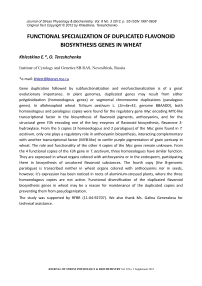Functional specialization of duplicated flavonoid biosynthesis genes in wheat
Автор: Khlestkina E., Tereshchenko O.
Журнал: Журнал стресс-физиологии и биохимии @jspb
Рубрика: Supplement
Статья в выпуске: 3 т.8, 2012 года.
Бесплатный доступ
Gene duplication, t. aestivum, gene myc
Короткий адрес: https://sciup.org/14323622
IDR: 14323622
Текст статьи Functional specialization of duplicated flavonoid biosynthesis genes in wheat
Original Text Copyright © 2012 by Khlestkina, Tereshchenko
FUNCTIONAL SPECIALIZATION OF DUPLICATED FLAVONOID BIOSYNTHESIS GENES IN WHEAT
Khlestkina E.*, O. Tereshchenko
Institute of Cytology and Genetics SB RAS, Novosibirsk, Russia
Gene duplication followed by subfunctionalization and neofunctionalization is of a great evolutionary importance. In plant genomes, duplicated genes may result from either polyploidization (homoeologous genes) or segmental chromosome duplications (paralogous genes). In allohexaploid wheat Triticum aestivum L. ( 2n = 6x =42, genome BBAADD), both homoeologous and paralogous copies were found for the regulatory gene Myc encoding MYC-like transcriptional factor in the biosynthesis of flavonoid pigments, anthocyanins, and for the structural gene F3h encoding one of the key enzymes of flavonoid biosynthesis, flavanone 3-hydroxylase. From the 5 copies (3 homoeologous and 2 paralogous) of the Myc gene found in T. aestivum , only one plays a regulatory role in anthocyanin biosynthesis, interacting complementary with another transcriptional factor (MYB-like) to confer purple pigmentation of grain pericarp in wheat. The role and functionality of the other 4 copies of the Myc gene remain unknown. From the 4 functional copies of the F3h gene in T. aestivum , three homoeologues have similar function. They are expressed in wheat organs colored with anthocyanins or in the endosperm, participating there in biosynthesis of uncolored flavonoid substances. The fourth copy (the B-genomic paralogue) is transcribed neither in wheat organs colored with anthocyanins nor in seeds, however, it’s expression has been noticed in roots of aluminium-stressed plants, where the three homoeologous copies are not active. Functional diversification of the duplicated flavonoid biosynthesis genes in wheat may be a reason for maintenance of the duplicated copies and preventing them from pseudogenization.
The study was supported by RFBR (11-04-92707). We also thank Ms. Galina Generalova for technical assistance.
JOURNAL OF STRESS PHYSIOLOGY & BIOCHEMISTRY Vol. 8 No. 3 Supplement 2012


